Agricultural Literacy Curriculum Matrix
Lesson Plan
Pig Power: Creating Biogas and Renewable Energy
Grade Level
Purpose
After exploring the science of energy and energy conversion, students will evaluate some environmental impacts of hog farming and explore technologies that minimize negative human impact by creating biogas energy from animal waste. Grades 9-12
Estimated Time
Materials Needed
Engage:
- Facts About Pigs Kahoot or Quizziz
- Environmental Impacts of Food and Agriculture infographic
Activity 1: Energy 101
Activity 2: Anaerobic Respiration + Biomass = Biogas
- Hog Production at Smithfield Foods video
- Energy Trace-back image
- The Power of Pig Poop: Renewable Energy Created from Manure video
- 1 empty water bottle
- 1 balloon
- 1 and 1/2 cups warm water
- 3 tablespoons yeast
- 3 tablespoons sugar
Activity 3: Using Science to Decrease Human Impact on the Environment
Vocabulary
anaerobic digestion: a series of biological processes in which microorganisms break down biodegradable material in the absence of oxygen. One of the end products is biogas
biomass: plant or animal material used for energy production, or in various industrial processes as raw substance for a range of products
by-product: an incidental or secondary product made in the manufacture or synthesis of something else
energy: power derived from the utilization of physical or chemical resources
fossil fuel: a natural fuel such as coal or petroleum formed in the geological past from the remains of living organisms
fuel: material such as coal, gas, or oil that is burned to produce heat or power
nonrenewable: a natural resource existing in finite quantity; not capable of being replenished
pork: meat that comes from pigs
sow: a female adult pig
swine: a pig
Did You Know?
- Wind has been used as a source of energy since 2000 BC. Today, wind energy is mostly harnessed by wind turbines found on "wind farms" that can stand as tall as a 20-story building.1
- In the United States, average energy consumption per person has doubled every 20 years, but scientists predict a 55% increase between 2008 and 2030.2
- The U.S. agriculture industry used 800 trillion BTUs (British thermal units) of energy in 2012.3
- The generation of power is a leading cause of air pollution and the single largest source of U.S. emissions contributing to global warming.4
Background Agricultural Connections
Energy and Energy Conversion
Energy comes in many forms to perform a variety of tasks. Gasoline and diesel fuel give power to vehicles, tractors, and generators. Electricity powers lights, irrigation systems, pumps, and heating and cooling systems. Propane and natural gas can be used as fuel for hot water heaters or propane dryers. Many of these energy sources are nonrenewable, meaning they have limited availability and could run out before they could be replenished. Fossil fuels are the most common nonrenewable energy source. A fuel is a substance that stores energy. Renewable energy sources are defined as those that can be replenished or replace themselves through natural reproduction or other processes. Biomass is an example of a renewable resource. Inexhaustible energy resources include solar, wind, water (hydro), and geothermal.
To make energy useful, it is converted from its original source and then transferred from one place to another. For example, solar panels collect energy from the sun and then transfer it from light energy to heat and electrical energy. Biomass is organic material that comes from plants and animals. Through photosynthesis, plants take and store energy from the sun. The resulting organic material is then burned directly or converted to a liquid biofuel or biogas that can be burned as a fuel. Consider the following examples:
- Wood is burned to heat buildings and can be used to generate electricity.
- Agricultural crops and waste materials can be burned as a fuel or converted to liquid biofuels.
- Food waste can be burned to generate electricity in power plants.
- Animal waste (manure) and human sewage can be converted to biogas and burned as a fuel.
Animal Agriculture and Manure Management
Animal agriculture produces protein-rich food to eat such as meat, milk, and eggs. These products come from farms of all sizes and types and are produced by animals such as cattle, sheep, pigs, chickens, and turkeys. Animal agriculture also produces many byproducts. A byproduct is an incidental or secondary product made in the manufacture or synthesis of something else. For example, pork meat is the primary product produced on a hog farm. However, other products such as pharmaceuticals (medications), leather, paint brush bristles, pet food, cosmetics, and more also come from pigs as byproducts. Organic by-products or "wastes" of the livestock industry include solid and liquid manures, used bedding, and spilled feed.4 However, manure accounts for the majority of animal waste products.
The proper management of manure is the responsibility of all animal farms regardless of the livestock they raise or the size of their operation. In reference to manure management, best management practices can help protect the environment, improve the health and well-being of livestock animals, and aid in the useful cycling of soil nutrients. Manure contains macronutrients such as nitrogen, phosphorus, and potassium as well as micronutrients such as calcium, magnesium, and sulfur. The nutrient value of manure depends on the animal species, feed ration, and the method of manure collection, but manure is part of many nutrient recycling programs.5
Manure management strategies on the farm vary by animal species and the type of housing the animals live in. Management strategies include plans for how manure is captured, stored, treated, and used.6 While manure can be a useful byproduct from an animal farm, its management also presents some challenges. For example, if not managed properly, manure can affect water quality. The over-application of manure nutrients to cropland can increase the risk of contaminating surface water. Manure contributes to greenhouse gas emissions representing 10% of GHG emissions from global livestock production.7 A final challenge to mention in the managment of manure is the odor that could impact residential areas located near animal farms. Odor intensity has many contributing factors including the farm's location, animal species, type of animal housing, and weather (especially moisture and wind). Technologies and research helps to improve strategies used by farmers to efficiently manage their manure waste.
Technological Solutions to Decrease Environmental Impact
Technological advancements in agriculture over previous decades have made it possible for farmers to feed a growing population by increasing both production and efficiency on the farm. Improved knowledge of science and genetics has helped farmers selectively breed livestock animals to be more efficient. Coupled with better animal nutrition, modern livestock farms yield high quantities of meat, milk, and eggs. Farms can be relatively small or large in size. Regardless of size or production style, animals produce waste that must be managed. Technology is finding solutions for effective uses for animal waste that decrease the environmental footprint of agriculture.
The science of anaerobic digestion captures energy from animal waste (manure). Basically, manure and other organic waste is loaded into an airtight tank where special anaerobic bacteria (that live without oxygen) consume the waste and give off methane. Methane is a very flammable gas (like propane) that can power generators efficiently. The process has benefits that include:
- Disposing of waste that can have harmful effects to water quality when not managed correctly. Treated manure can also be recycled on farmland as nutrient-rich, organic fertilizer for cropland in adherence with regulatory requirements.
- Preventing methane from entering the atmosphere. Methane is a greenhouse gas that is about 23 times more powerful than carbon dioxide in trapping heat in the atmosphere. By trapping and burning it up in generators, GHG impacts are avoided.
- Allowing farmers to generate electricity and heat from their own animal waste. Farmers who invest in digesters will see a return on their investment via free electricity and heat, often within ten years. This financial incentive is especially attractive given the rising cost of fuel.
- Controlling the smell from livestock operations. Digesters can also help farmers control the smell of livestock operations.
Engage
- Using Kahoot or Quizziz, have students take an introductory quiz to stimulate their thought about pigs and the environmental impact of human activities.
- After the quiz, have a discussion about the last two quiz questions. Draw on the students' background knowledge of natural resources and the concept of human impact on the environment by considering the following:
- Human impact on the environment includes changes to the environment caused directly or indirectly by humans. It includes events such as global warming, ocean acidification, pollution, deforestation, etc.
- Agriculture is the science or practice of farming for the growing of crops or rearing of animals to provide food, fiber, and other products.
- Agricultural practices require the use of natural resources like water, land, soil, and soil nutrients.
- The production of food and fiber on farms results in environmental impact.
- Project the image Environmental Impacts of Food and Agriculture. Use the infographic to introduce some of the environmental impacts created by the production of our food. If desired, students can explore more explantions and graphs from Our World in Data—Environmental impacts of food production.8
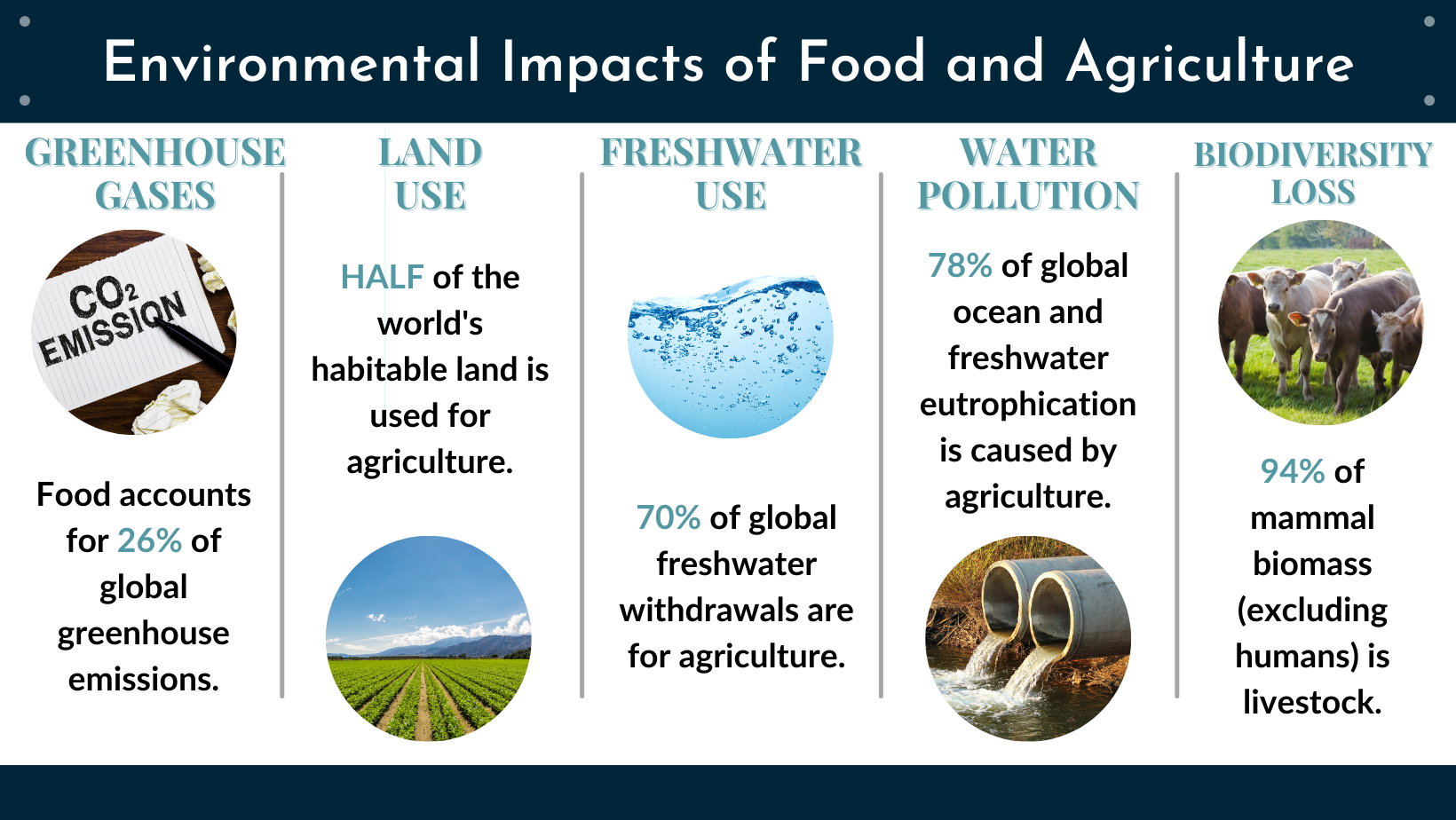
- Encourage higher level critical thinking as you review these five environmental impacts with discussion questions such as:
- Understanding that agriculture (the production of our food and fiber) has an impact on our environment, does that mean we should stop farming altogether? (No, agriculture provides food, fiber, and fuel that are necessary for our survival.)
- How can statistics such as these help us lessen environmental impact caused by agriculture? (They help us identify places where we can improve by researching better practices or improved technology.)
- What measures can be taken to manage the environmental impacts of agriculture? (Students can brainstorm ideas. Examples include increasing efficiency to lessen the need for land, developing plant varieties that are drought tolerant so they require less water, adapting farming practices that release greenhouse gases, or developing better management practices for animal waste that could pollute water sources.)
- Explain to students that they are going to take a deeper look at two of these five factors—greenhouse gases and water pollution.
| As you share statistics, emphasize to students that there are limitations to thoroughly and objectively evaluating the impact of human activities on our environment. As you proceed through the lesson, encourage students to think critically about the application of statistics and the limitations of what they are telling us. |
Explore and Explain
Activity 1: Energy 101
- Project/share the Energy Sources image for students to see. Have students study the images and determine what all eight pictures have in common. If needed, clarify what each picture is (Top, left to right: the sun, petroleum, wind, and animal manure. Bottom, left to right: coal, water, natural gas, corn.) Students should identify that each item is a source of energy.
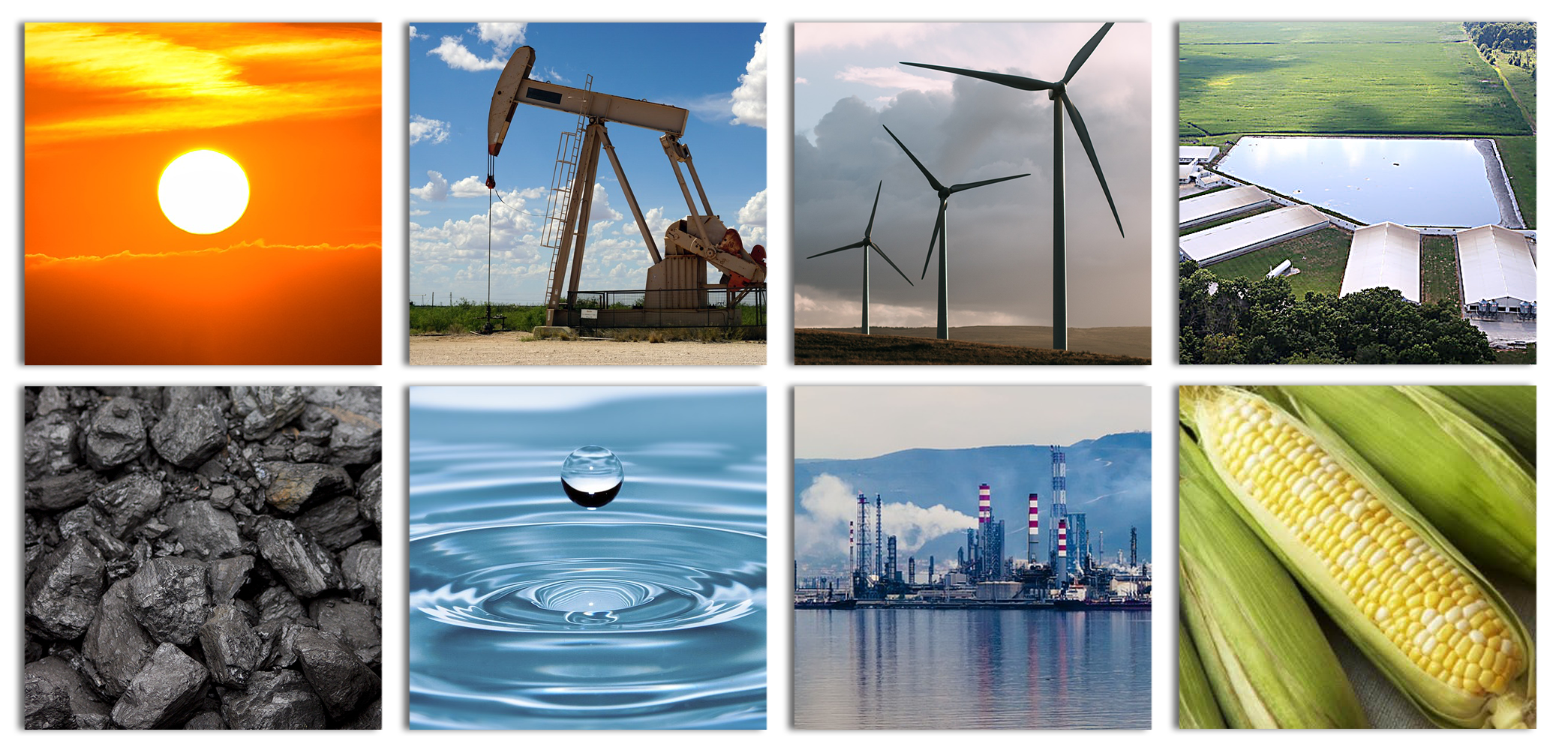
- Ask, "How does energy impact the environment?" (All forms of electricity generation have an environmental impact on our air, water and land, but it varies. Producing and using electricity more efficiently reduces both the amount of fuel needed to generate electricity and the amount of greenhouse gases and other air pollution emitted as a result.9)
- Show the Total U.S. Greenhouse Gas Emissions graph.10 As students begin interpreting the graph, note that greenhouse gas emissions only measure one type of environmental "footprint" from human activities. However, it does help us see that electricity is an area where we can improve.
- Provide each student with digital access to the Farming for Energy e-magazine.
- Instruct students to read the e-magazine and to click on all of the interactive links to better understand the science of energy.
- Once students have reviewed the e-magazine, ask questions to check for understanding and discover what questions they have.
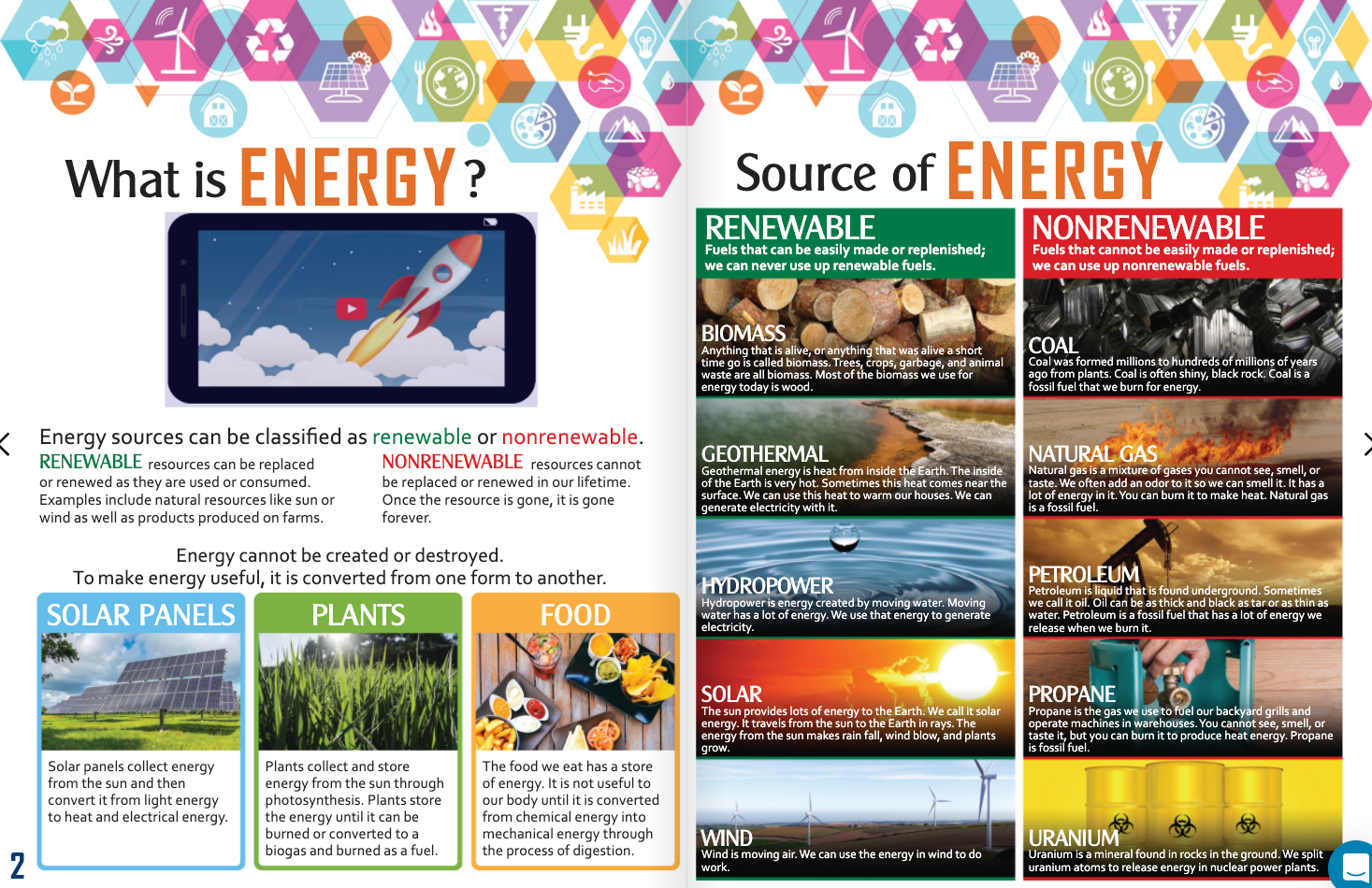
Activity 2: Anaerobic Respiration + Biomass = Biogas
- Review what biomass is by asking, "What is the definition of biomass?" (organic material from a plant or animal that can be used as fuel to produce electricity or heat.)
- Watch the video, Hog Production at Smithfield Foods. This 4 minute video clip illustrates the process of raising hogs on a modern farm. Instruct students to find a source of biomass that is produced on a hog farm.
Agricultural Literacy Teaching Tip:
The majority of pigs in the United States are raised in climate-controlled barns similar to what is seen in the video above. This style of housing allows farmers to provide ideal temperatures for the pigs regardless of the weather outside and allows greater biosecurity measures to keep the animals healthy and avoid disease. Some farms house their pigs in more open spaces often described as "free range" or "pasture raised" pig farms. Both animal housing styles provide benefits and drawbacks and can provide a context for applying science to evaluate animal welfare and environmental impact.
- After the video, ask students, "What biomass is created on a pig farm?" (manure)
- Have students identify the path of energy from the sun to pig manure. Use the Energy Trace-back image to help illustrate the path of energy.
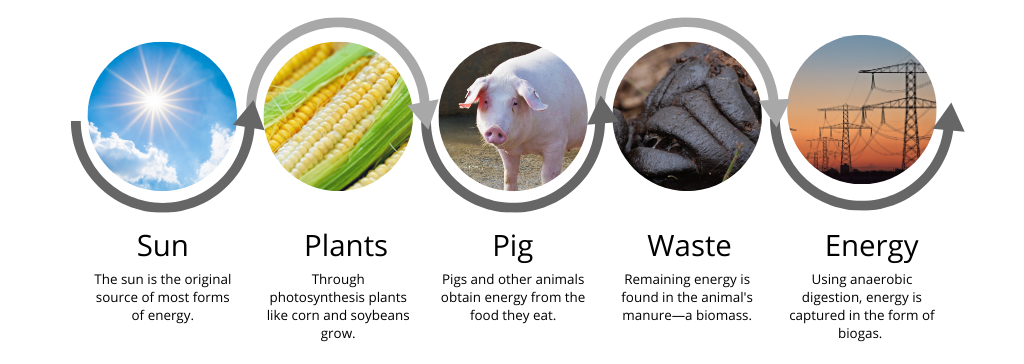
- To explain the final energy conversion from waste to energy, review with students the process of anaerobic respiration. Explain that in specific circumstances, cells need to create energy (ATP) without oxygen. They can do this through anaerobic respiration. Animal waste can be converted to a useable form of energy by combining anaerobic bacteria with hog manure resulting in biogas.
- To illustrate, show a video clip from The Power of Pig Poop: Renewable Energy Created from Manure. (Begin at 0:22 and stop at 1:33.)
- Use the following steps to create a small scale model to demonstrate the science that is taking place in a methane digester:
- Add 1 and 1/2 cups of warm water to an empty water bottle.
- Add 3 tablespoons of yeast and 3 tablespoons of sugar.
- Mix the water, yeast, and sugar together and place a balloon over the end of the bottle.
- As you perform each step, narrate the simulation. On a hog farm the manure from the pigs is flushed from the barn to covered lagoons (the water bottle). The manure is biomass represented in the simulation with sugar. Anaerobic bacteria (represented by yeast) is mixed with the manure, resulting in a biogas that can be used to power generators and create renewable electricity.
- Observe the changes that take place over the next 30-60 minutes as you move forward in the lesson.
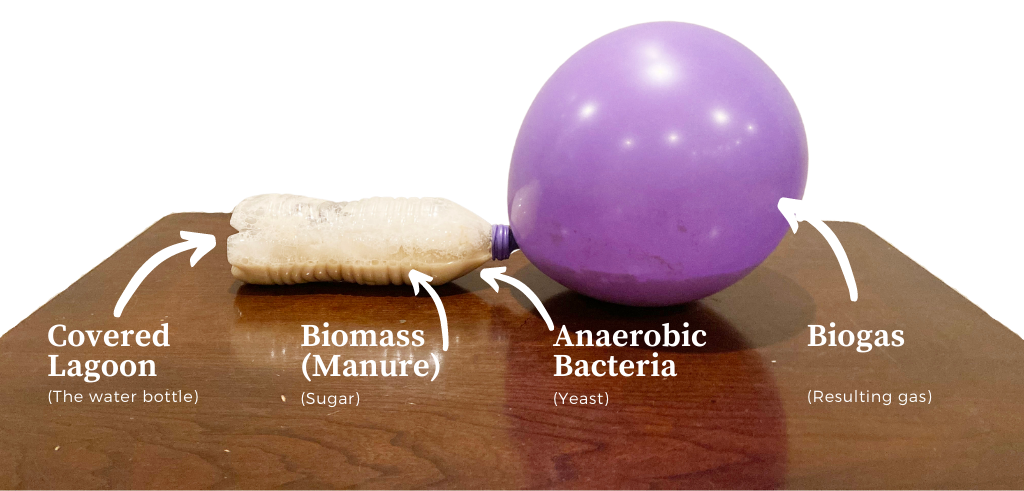
Activity 3: Using Science to Decrease Human Impact on the Environment
- Discuss the following perspectives, "Animal manure is waste" and "Animal manure is a resource." Have students share thoughts and reasoning behind both perspectives. Once students have discussed and brainstormed both perspectives, use the following Career Spotlight to introduce them to a career in environmental engineering.
|
Career Spotlight: Environmental Engineer Introduce students to careers in environmental engineering, a branch of engineering that uses a broad spectrum of scientific topics like chemistry, biology, ecology, geology, hydrology, microbiology, and math to manage human impacts on the environment. Watch Manure Management at Smithfield's Hog Production Division to see examples of challenges environmental engineers are tackling in pork production and their role in protecting the environment and helping farmers improve sustainability. |
- With a perspective in the role of environmental engineering and the application of science to decrease human impact on the environment, show the Turning Hog Waste into Environmentally Friendly Fertilizer video. As students watch the video, pause and discuss the following questions:
- What environmental impact concerns are associated with hog farming? (Air quality issues related to the odor of hog farms, the release of greenhouse gases, water contamination from the over-application of nutrient-rich manure to crop fields, or a storm that could overflow the lagoons and contaminate water sources.)
- In what ways have science and technology been used to mitigate these environmental concerns? (The manure treatment systems reduce the greenhouse gas emissions and the odor. In addition, the treatment systems manage the nutrients (macro and micro soil nutrients) to use them correctly without overapplying them to cropland.)
- Return to the perspectives, "Animal manure is waste" and "Animal manure is a resource." Have students record reasonings for both perspectives in a T-chart as they reflect on what they have learned. Has their opinion changed? Can evaluating our human impact on the environment in a specific area provide direction for improvement? Where does science and technology fit in the big picture?
| If students begin asking questions about the efficiency of generating power from biomass like animal manure, encourage them to keep asking questions. Is it cost effective to generate power from methane digesters? |
Elaborate
-
Discuss the difference between energy conservation and energy efficiency. Start by turning off the room lights. Ask the students if having the lights off is conserving energy. (Yes) Is it being energy efficient? (No, because with the lights off, no one can see to do anything.) Turn the heat/air conditioning on and open a window. Is this being energy efficient? (No) Is it conserving energy? (No) If it is a cold day, hold a coffee cup by the handle and then wrap your hands around the cup. Which one is more energy efficient? (wrapping hands around, because the coffee cup can warm cold hands as well as keep the liquid warm for a longer period of time) Based on these examples, ask students if they can tell the difference between energy conservation and energy efficiency. Solicit student responses.
-
Watch Careers in Renewable Energy to discover career paths associated to energy.
-
Watch Top 10 Energy Sources of the Future. Discuss the challenges each potential energy source poses as well as the benefits.
-
Have students take a 360° virtual tour of a wean-to-finish hog farm or a sow farm.
-
Ask students to brainstorm actions we can personally take to reduce our environmental impact. Examples students may think of include driving less, using public transportation, reducing plastic use, etc. Introduce the concept of climate smart agriculture as an approach for developing agricultural strategies to secure a sustainable food supply in the face of a changing climate. Assign students to explore agricultural practices that can decrease human impact to the environment along the farm to fork foodchain. As one example, explore the sustainability goals of Smithfield Foods, a pork producer and food processing company.
- Smithfield Foods Environment webpage
- Manure to Energy Program video
- Sustainable grain production video
Summarize by discussing the value of science and technology to evaluate agricultural practices and to make improvements. Assign students to explore other agricultural industries to observe the climate-smart improvements they are making. The Carbon Cycle and Climate Smart Agriculture lesson plan will also serve as a valuable resource.
-
Research energy efficient farms. Divide students into small groups and assign them a specific type of farm (swine, cattle, row crop, fruit, vegetable, etc.). Have students take on the role of an energy consultant and identify/explain the best practices for energy conservation and efficiency on the farm. Specific ideas include:
- Draw a layout of the property and explain how the location of buildings, animal housing facilities, and other tools lead to energy efficiency.
- Identify energy conservation and energy efficiency practices and how they are implemented.
- Discuss building and machinery maintenance and its connection to energy efficiency.
Evaluate
After completing these activities, review and summarize the following key points:
- Energy can be captured from many sources in our environment. Energy is made useful to humans as it is transferred and converted into useable forms.
- Human actions have short and long term effects on our sustainability, or our ability to use agricultural practices and natural resources in a way that can be sustained long term.
- The agricultural practices we use to produce our food, fuel, and fiber have environmental impacts. Science and technology can be used to mitigate negative environmental impacts.
Sources
- https://www.conserve-energy-future.com/various-wind-energy-facts.php
- https://www.reference.com/article/interesting-energy-3128fbc84b036c54?aq=interesting+facts+about+energy&qo=cdpArticles
- https://www.eia.gov/todayinenergy/detail.php?id=18431
- https://www.nrcs.usda.gov/wps/portal/nrcs/detail/national/technical/?cid=nrcs143_014211
- https://ag.umass.edu/crops-dairy-livestock-equine/fact-sheets/manure-nutrient-resource
- https://www.ers.usda.gov/topics/farm-practices-management/crop-livestock-practices/manure-management
- http://www.fao.org/news/story/en/item/197623/icode/
- https://ourworldindata.org/environmental-impacts-of-food
- https://www.epa.gov/energy/learn-about-energy-and-its-impact-environment
- https://www.epa.gov/ghgemissions/sources-greenhouse-gas-emissions
Acknowledgements
This lesson was created with support from Smithfield Foods, Inc. for National Agriculture in the Classroom. Smithfield has pioneered sustainability standards for more than two decades, including its industry-leading commitments to become carbon negative in U.S. company-owned operations and reduce GHG emissions 30% across its entire U.S. value chain by 2030. More information on their environmental goals can be found on their environment page.
Recommended Companion Resources
Author
Organization
| We welcome your feedback! If you have a question about this lesson or would like to report a broken link, please send us an email. If you have used this lesson and are willing to share your experience, we will provide you with a coupon code for 10% off your next purchase at AgClassroomStore. |
